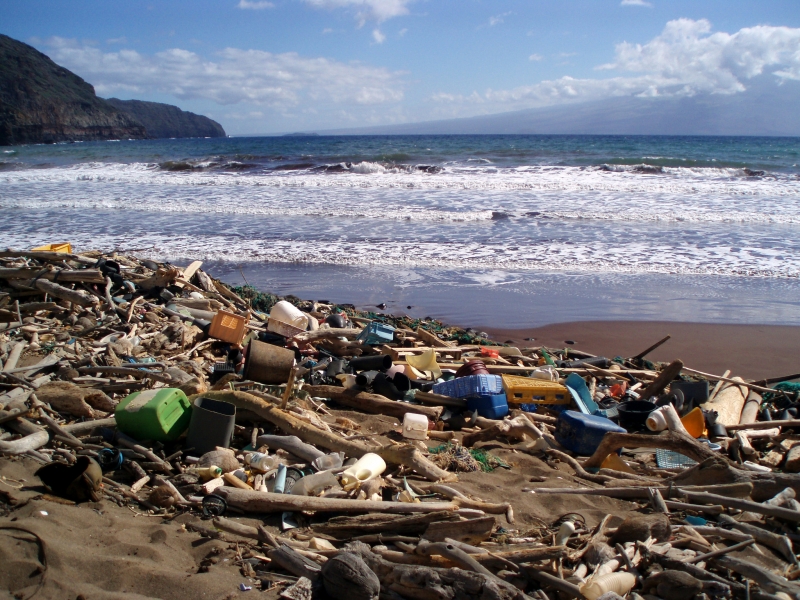The Great Pacific Garbage Patch, a collection of marine debris swirling around the north Pacific Ocean, is estimated by some scientists to be roughly the same size as the state of Texas. While the Garbage Patch moniker can conjure images of a physical trash island, in reality, it is almost entirely made up of microplastics not always seen by the eye, turning the sea into a cloudy soup. Around 80% of the debris comes from land-based sources in North America and Asia.
This is just one example of the impact marine litter, defined as “any persistent, manufactured, or processed solid material that is discarded, disposed of, or abandoned in the marine and coastal environment,” has on our oceans. Marine litter, also known as marine debris, cannot be traced back to a single source, but originates from both land-based sources (such as stormwater runoff, industrial outfalls, and landfills sited near coastal areas) and sea-based sources (such as material dumped at sea and lost or abandoned fishing gear). The problem stems from decades of changing production and consumption patterns, poor waste management, and regulatory gaps. In order to tackle this bigger-than-Texas issue, a comprehensive regulatory framework is needed.
A number of key international legal instruments and provisions aim to address the problem, taking the form of multilateral environmental agreements, soft law, international legal principles, and customary international law. These instruments address a variety of issues, including prevention of land- and sea-based pollution and the prevention of marine degradation. While many countries use laws and policies that provide a general framework to reduce the spread and the creation of solid waste, these rarely address the creation of marine litter in particular.
The tide, however, is turning: the United States mandates research on marine litter; Rwanda and Bangladesh have banned plastic bags; and Japan and Singapore have legislative frameworks in place to address the issue, to name a few examples.
In September 2016, ELI released “Marine Litter Legislation: A Toolkit for Policymakers,” a report developed for the United Nations Environment Programme. The report examines legislation that nations have adopted to prevent and manage marine litter, providing information and examples for legislative approaches to addressing the problem in order to inspire new regulatory frameworks and share best practices.
 |
| Photo by NOAA News 2013 September 4 |
Countries may choose to adopt either a piecemeal or a comprehensive approach to addressing marine litter. In addition to recommending the creation and strengthening of laws advocating for the prevention and removal of marine litter, the report recommends that countries elect to adopt a comprehensive, holistic approach to marine litter management; enact legislation providing an overarching framework for preventing, reducing, and otherwise managing marine litter; and establish an interagency mechanism for coordinating among the diverse sectors with a role in addressing marine litter. For example, Japan adopted the Law for the Promotion of Marine Litter Disposal (LPMLD) in 2009 for the purpose of controlling and reducing marine litter. The law mandates that the central government formulate a marine litter policy, that prefectural governments formulate regional plans, and it encourages cooperation among public, private, and international sectors. Under Article 30 of the LPMLD, the Japanese government must establish a Council for Promoting Countermeasures Against Marine Litter.
The ELI report recommends that countries that adopt a more piecemeal approach toward marine litter may develop and implement laws to ban or diminish the production of single-use trash items and other waste that is commonly found in marine litter; regulate non-recoverable items, such as plastic microbeads in personal care and cosmetics products; develop and implement legislation to prevent the waste, once created, from entering the marine environment; and support marine litter cleanup efforts. Several national and subnational laws prohibit the manufacturing of products that can become marine litter. Notably, California regulates the manufacture and handling of nurdles (pre-production plastics). Bangladesh became the first country to ban plastic bags due to concerns of loss of arable land due to plastics in the soil and flooding due to clogged drains. And the Canadian government added microbeads to the List of Toxic Substances under the Canadian Environmental Protection Act in June 2016, meaning that the government can now develop regulations to prohibit their manufacture, import, and sale.
Regardless of whether a country adopts a comprehensive or piecemeal approach to marine litter, there is a wide range of legal and policy approaches that are important for addressing marine litter—including collecting and accessing data and information; requiring agencies to report on progress; conducting baseline assessments; setting goals for litter reduction; addressing prevention, remediation, coordination, and planning; creating incentives through market-based instruments; and public participation and awareness-raising. Irrespective of which approach a country chooses, one thing is certain: strong governance and effective rule of law are necessary to stem the flow of plastics and other forms of debris into our global oceans.
